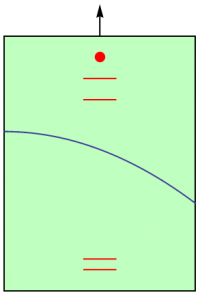- §1. Line Elements
- §2. Circle Trig
- §3. Hyperbola Trig
- §4. Geometry of SR
- §5. Differential Forms
- §6. Geodesics
- §7. The Physics of GR
The Physics of General Relativity
There are three key ideas underlying Einstein's theory of general relativity:
- Principle of Relativity:
The principle of relativity originates with Galileo, and says that the results of experiments do not depend on relative (uniform) motion of observers. Einstein's contribution was to apply this principle to electromagnetism. Since the speed of light can be computed from the constants in Maxwell's equations, the speed of light must be independent of the observer. This postulate leads directly to special relativity. - Equivalence Principle:
The equivalence principle is due to Newton, and says that gravity affects everything the same way. Examples include dropping objects of different mass off the leaning tower of Pisa, and dropping a hammer and an eagle feather on the moon. Einstein's contribution was to propose that acceleration is equivalent to gravity, so that a freely falling frame observes no (local) gravity; falling objects float in such a frame. Einstein further interpreted this to mean that freely falling observers move “straight”, that is, on geodesics. 1) - Mach's Principle:
Mach's principle is due, not surprisingly, to Mach, and says that all the matter in the universe affects the local notion of acceleration. Einstein's interpretation is that the matter in the universe curves spacetime, and that this curvature then tells objects how to move under the influence of gravity. In other words, “matter = curvature”, which leads to general relativity.
Simple applications of these ideas imply that gravity bends light, and that clocks in a gravitational field run slow. Both of these results follow by considering an accelerating rocket ship out in space, as shown in Figure 1. A beam of light shining through the windows that is horizontal as seen by an inertial observer follows the parabolic trajectory shown as seen by an observer on the ship. Similarly, pulses of light sent from the front (top) of the rocket to the back (bottom), indicated by the horizontal lines, will arrive more quickly than expected, since the back is accelerating to meet it, resulting in the interval between pulses being shorter upon reception than at emission. The back observer therefore thinks that the front observer's clock is running fast. Since acceleration is equivalent to gravity, both properties must also hold in a gravitational field. That is, gravity bends light, and clocks in a gravitational field tick at a slower rate than those that aren't. Equivalently, clocks in orbit tick at a faster rate than those on the ground.
The bending of light by gravity was the prediction that made Einstein famous, when this prediction was confirmed by Eddington during an eclipse in 1919. And the different rate of clocks on satellites must be taken into account by global positioning systems.
